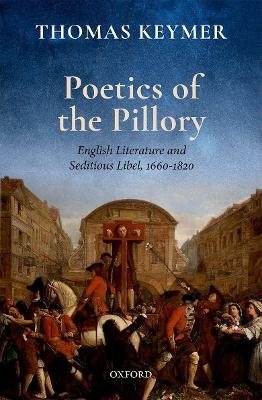
Poetics of the Pillory
Oxford University Press (Verlag)
978-0-19-874449-8 (ISBN)
On the lapse of the Licensing Act in 1695, Thomas Macaulay wrote in his History of England, 'English literature was emancipated, and emancipated for ever, from the control of the government'. It's certainly true that the system of prior restraint enshrined in this Restoration measure was now at an end, at least for print. Yet the same cannot be said of government control, which came to operate instead by means of post-publication retribution, not pre-publication licensing, notably for the common-law offence of seditious libel. For many of the authors affected, from Defoe to Cobbett, this new regime was a greater constraint on expression than the old, not least for its alarming unpredictability, and for the spectacular punishment--the pillory--that was sometimes entailed. Yet we may also see the constraint as an energizing force. Throughout the eighteenth century and into the Romantic period, writers developed and refined ingenious techniques for communicating dissident or otherwise contentious meanings while rendering the meanings deniable.
As a work of both history and criticism, this book traces the rise and fall of seditious libel prosecution, and with it the theatre of the pillory, while arguing that the period's characteristic forms of literary complexity--ambiguity, ellipsis, indirection, irony--may be traced to the persistence of censorship in the post-licensing world. The argument proceeds through case studies of major poets and prose writers including Dryden, Defoe, Pope, Fielding, Johnson, and Southey, and also calls attention to numerous little-known satires and libels across the extended period.
Thomas Keymer is Chancellor Henry N. R. Jackman University Professor of English at the University of Toronto. Before moving to Toronto in 2006, he taught for six years at Royal Holloway, University of London, and for ten years at St Anne's College, Oxford. He is a Fellow of the Royal Society of Canada, the Royal Historical Society, and the English Association, and has also held fellowships with the John Simon Guggenheim Memorial Foundation, the Leverhulme Trust, and All Souls College, Oxford. His work is mainly focused on Restoration, eighteenth-century, and Romantic-era British and Irish literature. Between 2013 and 2017 he directed the University of Toronto's Graduate Program in Book History & Print Culture, and he currently serves as General Editor of the Review of English Studies (OUP) and co-General Editor of the Cambridge Edition of the Works & Correspondence of Samuel Richardson.
Introduction
1660-1700. Faint Meaning: Dryden and Restoration Censorship
1700-1740. Libels in Hieroglyphics: Pope, Defoe
1730-1780. The Trade of Libelling: Fielding, Johnson
1780-1820. Southey's New Star Chamber: Literature, Revolution, and Romantic-Era Libel
Conclusion: England in 1820
| Erscheinungsdatum | 22.11.2019 |
|---|---|
| Reihe/Serie | Clarendon Lectures in English |
| Zusatzinfo | 31 Illustrations |
| Verlagsort | Oxford |
| Sprache | englisch |
| Maße | 136 x 200 mm |
| Gewicht | 482 g |
| Themenwelt | Geisteswissenschaften ► Sprach- / Literaturwissenschaft ► Anglistik / Amerikanistik |
| Geisteswissenschaften ► Sprach- / Literaturwissenschaft ► Literaturwissenschaft | |
| Sozialwissenschaften ► Soziologie | |
| ISBN-10 | 0-19-874449-8 / 0198744498 |
| ISBN-13 | 978-0-19-874449-8 / 9780198744498 |
| Zustand | Neuware |
| Haben Sie eine Frage zum Produkt? |
aus dem Bereich


